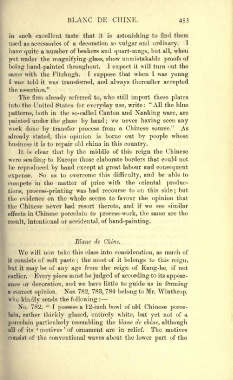Page 489 - Chinese Porcelain Vol II, Galland
P. 489
BLANC DE CHINE. 453
in such excellent taste that it is astonishing to find them
used as accessories of a decoration so vulgar and ordinary. I
have a number of beakers and but all, when
quite quart-mugs,
put under the magnifying -glass, show unmistakable proofs of
being hand-painted throughout. I expect it will turn out the
same with the Fitzhugh. I suppose that when I was young
I was told it was transferred, and thereafter
always accepted
the assertion."
The firm referred to, who still these
already import plates
"
into the United States for everyday use, write : All the blue
both in the so-called Canton and
patterns, Nanking ware, are
painted under the glaze by hand ; we never having seen any
work done by transfer process from a Chinese source." As
already stated, this opinion is borne out by people whose
business it is to old china in this
repair country.
It is clear that by the middle of this reign the Chinese
were to those elaborate borders that could not
sending Europe
be reproduced by hand except at great labour and consequent
So as to overcome this and be able to
expense. difficulty,
in the matter of with the oriental
compete price produc-
was had recourse to on this side; but
tions, process-printing
the evidence on the whole seems to favour the opinion that
the Chinese never had resort thereto, and if we see similar
effects in Chinese to the same are the
porcelain process-work,
result, intentional or accidental, of hand-painting.
Blane de Chine.
We will now take this class into consideration, as much of
it consists of soft paste ; the most of it belongs to this reign,
but it may be of any age from the reign of Kang-he, if not
earlier. Every piece must be judged of according to its appear-
ance or decoration, and we have little to guide us in f6rming
a correct opinion. Nos. 782, 783, 784 belong to Mr. Winthrop,
who kindly sends the following :
"
No. 782. I a 12-inch bowl of old Chinese
possess porce-
lain, rather thickly glazed, entirely white, but yet not of a
porcelain particularly resembling the Ulanc de chine, although
' motives '
all of its of ornament are in relief. The motives
consist of the conventional waves about the lower part of the

